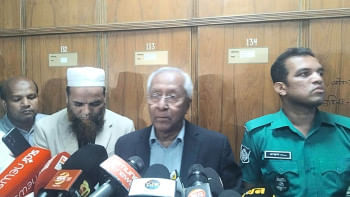Why we should be worried about the latest revision of DAP

With an estimated population of more than 2.4 crore people, Dhaka has become Bangladesh's central growth engine, contributing around 40 percent of the country's GDP. The unplanned urban growth of Dhaka came at the cost of the environment, liveability, and sustainability of the city. It ranked as the third least liveable city in the world in 2025, only surpassing the cities in active war zones. This should have been a wake-up call for the policymakers of our country. They should have implemented radical policy measures to fix this dysfunctional city and make the lives of millions of people in the city bearable. However, instead of putting forward progressive and stringent planning policies to save the city, the revised Detailed Area Plan (DAP) 2022-2035 of Dhaka was approved in principle by the interim government last week, despite opposition from urban planners.
After years of unplanned development due to unimplemented master plans, the DAP 2022-2035 marked a positive shift in urban planning when it was gazetted in August 2022. A team of experts, along with the Rajdhani Unnayan Kartripakkha (Rajuk), conducted research, held numerous meetings and consultations to finalise the document. Despite its limitations, the initial document was a step in the right direction to rescue Dhaka city from its woes. Rather than taking a singular approach for all areas, it took a spatial planning approach locally and contextually by dividing the city into 350 density zones. These zones determined the building heights, area, and units based on existing infrastructure such as road conditions, common facilities, and the character of an area. Within a year of the gazette's publication, Rajuk caved in to the pressure from real estate businesses and landowners, increasing the floor area ratio (FAR) in some areas.
The floor area ratio has been a point of contention for real estate businesses and construction professionals (architects, engineers, etc) because it determines the volume and floor area of a plot. A larger FAR means a bigger structure can be built on the land, and a larger structure translates into bigger profits for the companies and professionals. On the other hand, the government and urban planners use FAR as a mechanism to control the density of an area based on the utility infrastructure and common facilities to ensure the quality of life for residents and to preserve the environment. Dhaka needs contractionary measures for its exploding population density, which already exceeds the international standard by a long margin. Whether Rajuk had the willingness to implement the DAP or not, the original document provided an instrument that people and the government could use if they wanted to.
After the July uprising, the interim government assumed power with several reform agendas as priorities. Commissions were formed with experts, and they produced reports with recommendations for reforms in various areas. Obviously, it came as a shock to us when the government, under pressure from the Real Estate and Housing Association of Bangladesh (Rehab) and the Institute of Architects Bangladesh (IAB), took the initiative of revising the DAP (2022-2035) once more. Ignoring the pleas from environmental and citizens' rights activists, academics, urban planners, and several architects, the government reduced the number of density zones in DAP by five times, which increased the FAR significantly in many of the areas. DAP had a provision of revising the document every five years if needed, but the government changed the document twice since its finalisation in 2022, without any sort of technical justification. It begs the question, why was the interim government so eager to revise the DAP, putting the liveability of Dhaka city in jeopardy, even when the matter was not part of their reform agenda?
One of the main arguments Rehab put forward to revise the FAR was that restricting the number of units would decrease the affordability of the properties. Although it seems like a fair argument, other factors that made real estate unaffordable have been completely ignored. According to various media reports, the provision of allowing black money in the real estate sector has heavily inflated the market in the last decades and taken it out of reach of ordinary citizens. Instead of putting a stop to this issue of black money injection in the real estate sector, the interim government fulfilled Rahab's demand of revising the DAP as a cherry on top.
Real estate businesses and related professionals also argued that the FAR provided according to the density zones in the original DAP is "discriminatory," because it gave a higher FAR to affluent zones, in other words, the option to build more units. However, instead of demanding a reduction in the FAR of the affluent zones to end discrimination, they pushed for increasing the FAR in areas with narrow roads and poor utility services and management. Their demand was anti-people, purely profit-driven, and counterintuitive to any planning principle.
The revision of DAP threatens Dhaka's liveability and sets a dangerous precedent. Without taking the initiative to decentralise Dhaka, the government preferred short-term growth over long-term sustainability. The people who endorse the revised document should ask themselves whether they or future governments will have the capacity to develop the infrastructure to ensure the services to the millions who call Dhaka their home. The city's density is already taking a toll on people's standard of living. Are there any plans to handle the increased population density that will come from increasing the building heights?
Our recent experiences with fire hazards exposed the inadequacies in infrastructure and emergency services. Experts' kept warning about the lack of preparedness against earthquakes. With no clear direction on how to handle the increased risk that will arise from more buildings and increased population density, the revised DAP might as well be the last nail in Dhaka's coffin as a functional city.
Amirul Rajiv and Naim Ul Hasan are coordinators at the Bangladesh Tree Protection Movement.
Views expressed in this article are the author's own.
Follow The Daily Star Opinion on Facebook for the latest opinions, commentaries and analyses by experts and professionals. To contribute your article or letter to The Daily Star Opinion, see our guidelines for submission.


 For all latest news, follow The Daily Star's Google News channel.
For all latest news, follow The Daily Star's Google News channel. 








Comments